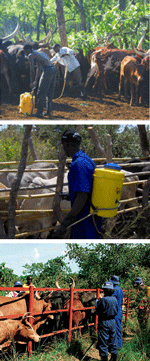STAMP OUT SLEEPING SICKNESS
|
|
Introduction to the stamp out sleeping sickness project
Background to sleeping sickness in Uganda
The spread of sleeping sickness in Uganda
Communication of research to communities and policy makers
|
Communication of research to communities and policy makersAs part of the Livestock for Life initiative, the Wellcome Trust has funded a communication programme to ensure that the key findings of the initiative are communicated to the communities, whilst also educating the livestock owners about the diseases and the risks to their animals as well as to themselves and their community. An informed human health and animal health service, and an informed population, will be key in minimising the severe impact of a crossover between these two diseases. The existing knowledge base among all sectors of the community potentially affected by Sleeping Sickness will be evaluated in districts that have recently been affected, looking at awareness of the disease’s symptoms and treatment availability; clinical signs in domestic animals, treatment options and mechanisms for avoidance of the form of the disease that affects livestock. Any knowledge gaps that are identified will be closed through design of messages to be developed through engagement of stakeholders with
To emphasise the danger of the two forms of disease becoming sympatric; the link between livestock and human form of the disease; disease presentation and appropriate treatment in livestock and humans, benefits of treating cattle with appropriate drugs and insecticides, disease risk factors and measures for risk avoidance. Best-bet communication channels for delivery and dissemination of information, will be identified, appropriate for target audiences comprising policy makers, cattle keepers and non-cattle keepers in the affected districts, and the broader community including civil society and the private sector. The project will disseminate information and monitor and evaluate the uptake and impact of messaging. Through these means, the Initiative will be widely understood by the local community, whilst influencing policy makers at the local and national level. Further information:
This website holds no responsibility for the information that external links may contain.
|
 |